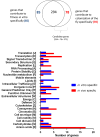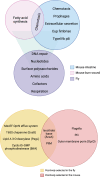Massively parallel mutant selection identifies genetic determinants of Pseudomonas aeruginosa colonization of Drosophila melanogaster
- PMID: 38380971
- PMCID: PMC10949475
- DOI: 10.1128/msystems.01317-23
Massively parallel mutant selection identifies genetic determinants of Pseudomonas aeruginosa colonization of Drosophila melanogaster
Abstract
Pseudomonas aeruginosa is recognized for its ability to colonize diverse habitats and cause disease in a variety of hosts, including plants, invertebrates, and mammals. Understanding how this bacterium is able to occupy wide-ranging niches is important for deciphering its ecology. We used transposon sequencing [Tn-Seq, also known as insertion sequencing (INSeq)] to identify genes in P. aeruginosa that contribute to fitness during the colonization of Drosophila melanogaster. Our results reveal a suite of critical factors, including those that contribute to polysaccharide production, DNA repair, metabolism, and respiration. Comparison of candidate genes with fitness determinants discovered in previous studies on P. aeruginosa identified several genes required for colonization and virulence determinants that are conserved across hosts and tissues. This analysis provides evidence for both the conservation of function of several genes across systems, as well as host-specific functions. These findings, which represent the first use of transposon sequencing of a gut pathogen in Drosophila, demonstrate the power of Tn-Seq in the fly model system and advance the existing knowledge of intestinal pathogenesis by D. melanogaster, revealing bacterial colonization determinants that contribute to a comprehensive portrait of P. aeruginosa lifestyles across habitats.IMPORTANCEDrosophila melanogaster is a powerful model for understanding host-pathogen interactions. Research with this system has yielded notable insights into mechanisms of host immunity and defense, many of which emerged from the analysis of bacterial mutants defective for well-characterized virulence factors. These foundational studies-and advances in high-throughput sequencing of transposon mutants-support unbiased screens of bacterial mutants in the fly. To investigate mechanisms of host-pathogen interplay and exploit the tractability of this model host, we used a high-throughput, genome-wide mutant analysis to find genes that enable the pathogen P. aeruginosa to colonize the fly. Our analysis reveals critical mediators of P. aeruginosa establishment in its host, some of which are required across fly and mouse systems. These findings demonstrate the utility of massively parallel mutant analysis and provide a platform for aligning the fly toolkit with comprehensive bacterial genomics.
Keywords: TnSeq; host–microbe interactions; host–pathogen interactions; oral infections.
Conflict of interest statement
The authors declare no conflict of interest.
Figures




Update of
-
Massively parallel mutant selection identifies genetic determinants of Pseudomonas aeruginosa colonization of Drosophila melanogaster.bioRxiv [Preprint]. 2023 Nov 21:2023.11.20.567573. doi: 10.1101/2023.11.20.567573. bioRxiv. 2023. Update in: mSystems. 2024 Mar 19;9(3):e0131723. doi: 10.1128/msystems.01317-23. PMID: 38045230 Free PMC article. Updated. Preprint.
Similar articles
-
Massively parallel mutant selection identifies genetic determinants of Pseudomonas aeruginosa colonization of Drosophila melanogaster.bioRxiv [Preprint]. 2023 Nov 21:2023.11.20.567573. doi: 10.1101/2023.11.20.567573. bioRxiv. 2023. Update in: mSystems. 2024 Mar 19;9(3):e0131723. doi: 10.1128/msystems.01317-23. PMID: 38045230 Free PMC article. Updated. Preprint.
-
Genome-Wide Mutagenesis in Borrelia burgdorferi.Methods Mol Biol. 2018;1690:201-223. doi: 10.1007/978-1-4939-7383-5_16. Methods Mol Biol. 2018. PMID: 29032547
-
NirA Is an Alternative Nitrite Reductase from Pseudomonas aeruginosa with Potential as an Antivirulence Target.mBio. 2021 Apr 20;12(2):e00207-21. doi: 10.1128/mBio.00207-21. mBio. 2021. PMID: 33879591 Free PMC article.
-
Using model systems to unravel host-Pseudomonas aeruginosa interactions.Environ Microbiol. 2023 Oct;25(10):1765-1784. doi: 10.1111/1462-2920.16440. Epub 2023 Jun 8. Environ Microbiol. 2023. PMID: 37290773 Review.
-
Pseudomonas aeruginosa: pathogenesis, virulence factors, antibiotic resistance, interaction with host, technology advances and emerging therapeutics.Signal Transduct Target Ther. 2022 Jun 25;7(1):199. doi: 10.1038/s41392-022-01056-1. Signal Transduct Target Ther. 2022. PMID: 35752612 Free PMC article. Review.
Cited by
-
Secreted retropepsin-like enzymes are essential for stress tolerance and biofilm formation in Pseudomonas aeruginosa.bioRxiv [Preprint]. 2025 Apr 6:2025.03.18.643919. doi: 10.1101/2025.03.18.643919. bioRxiv. 2025. Update in: mBio. 2025 Jul 9;16(7):e0087225. doi: 10.1128/mbio.00872-25. PMID: 40166241 Free PMC article. Updated. Preprint.
-
Massively parallel mutant selection identifies genetic determinants of Pseudomonas aeruginosa colonization of Drosophila melanogaster.bioRxiv [Preprint]. 2023 Nov 21:2023.11.20.567573. doi: 10.1101/2023.11.20.567573. bioRxiv. 2023. Update in: mSystems. 2024 Mar 19;9(3):e0131723. doi: 10.1128/msystems.01317-23. PMID: 38045230 Free PMC article. Updated. Preprint.
-
Secreted retropepsin-like enzymes are essential for stress tolerance and biofilm formation in Pseudomonas aeruginosa.mBio. 2025 Jul 9;16(7):e0087225. doi: 10.1128/mbio.00872-25. Epub 2025 Jun 3. mBio. 2025. PMID: 40459290 Free PMC article.
References
-
- Apidianakis Y, Mindrinos MN, Xiao W, Lau GW, Baldini RL, Davis RW, Rahme LG. 2005. Profiling early infection responses: Pseudomonas aeruginosa eludes host defenses by suppressing antimicrobial peptide gene expression. Proc Natl Acad Sci U S A 102:2573–2578. doi:10.1073/pnas.0409588102 - DOI - PMC - PubMed
MeSH terms
Substances
Grants and funding
LinkOut - more resources
Full Text Sources
Molecular Biology Databases

